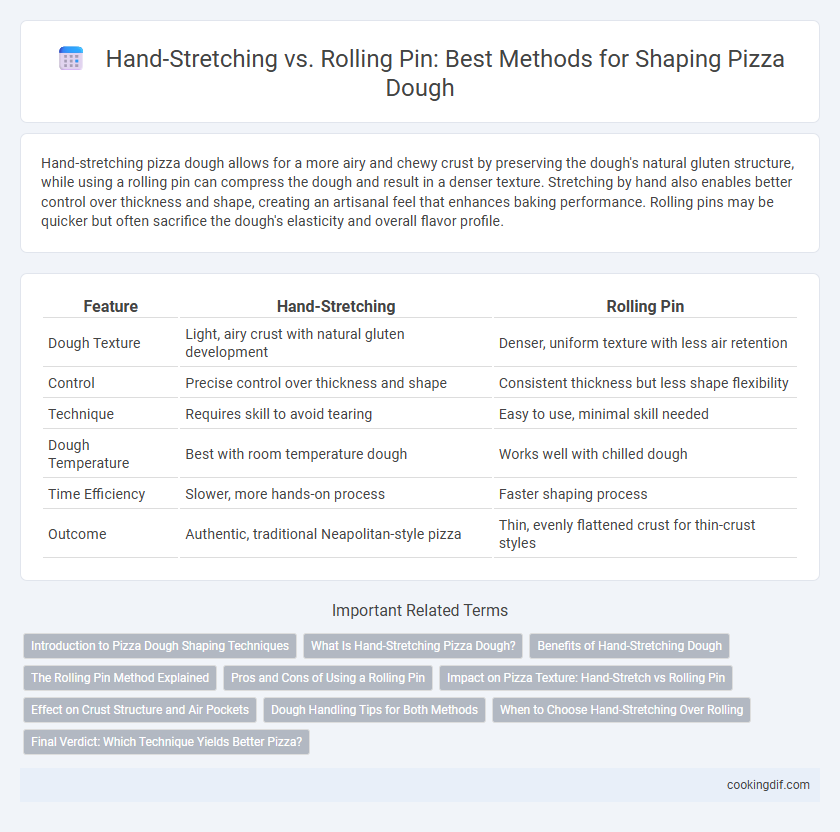Hand-stretching pizza dough allows for a more airy and chewy crust by preserving the dough's natural gluten structure, while using a rolling pin can compress the dough and result in a denser texture. Stretching by hand also enables better control over thickness and shape, creating an artisanal feel that enhances baking performance. Rolling pins may be quicker but often sacrifice the dough's elasticity and overall flavor profile.
Table of Comparison
| Feature | Hand-Stretching | Rolling Pin |
|---|---|---|
| Dough Texture | Light, airy crust with natural gluten development | Denser, uniform texture with less air retention |
| Control | Precise control over thickness and shape | Consistent thickness but less shape flexibility |
| Technique | Requires skill to avoid tearing | Easy to use, minimal skill needed |
| Dough Temperature | Best with room temperature dough | Works well with chilled dough |
| Time Efficiency | Slower, more hands-on process | Faster shaping process |
| Outcome | Authentic, traditional Neapolitan-style pizza | Thin, evenly flattened crust for thin-crust styles |
Introduction to Pizza Dough Shaping Techniques
Hand-stretching pizza dough preserves its air bubbles, resulting in a lighter, chewier crust that retains a traditional texture. Using a rolling pin compresses the dough, often leading to a denser, less airy base that may affect baking performance. Mastering both techniques allows pizza makers to achieve desired crust characteristics tailored to different styles like Neapolitan or New York-style pizza.
What Is Hand-Stretching Pizza Dough?
Hand-stretching pizza dough involves gently pulling and stretching the dough using hands to achieve a thin, even base without crushing the air bubbles that create a light crust. This traditional method preserves the dough's texture and allows for better control over thickness and shape compared to using a rolling pin. Skilled pizza makers prefer hand-stretching for its ability to maintain dough elasticity and create a more artisan-style crust.
Benefits of Hand-Stretching Dough
Hand-stretching dough preserves air bubbles created during fermentation, resulting in a lighter, airier pizza crust with a more desirable chewy texture. This method also allows for greater control over dough thickness and shape, ensuring an evenly stretched base without tearing. Unlike rolling pins, hand-stretching maintains the dough's gluten structure, enhancing the crust's overall flavor and crispiness after baking.
The Rolling Pin Method Explained
The rolling pin method for shaping pizza dough involves evenly flattening the dough with a cylindrical tool to achieve a consistent thickness, which is ideal for uniform baking. This technique allows precise control over the dough's diameter and thickness, creating a smooth surface without tearing or overstretching the gluten network. It is especially effective for thinner crust styles, ensuring a balanced base that supports toppings evenly while maintaining a crisp edge.
Pros and Cons of Using a Rolling Pin
Using a rolling pin to shape pizza dough offers consistent thickness and ease of use, making it ideal for beginners seeking uniform crusts. However, it can compress the dough, reducing air bubbles and resulting in a denser, less airy texture compared to hand-stretching. Rolling pins may also limit dough elasticity, affecting the traditional chewy and light quality favored in Neapolitan-style pizzas.
Impact on Pizza Texture: Hand-Stretch vs Rolling Pin
Hand-stretching pizza dough preserves its air bubbles, resulting in a light and airy crust with a chewy texture, which is ideal for traditional Neapolitan-style pizzas. Using a rolling pin compresses these air pockets, creating a denser and thinner crust that tends to be crispier and less elastic. The choice between hand-stretching and rolling pin directly influences the pizza's mouthfeel and overall texture, shaping the eating experience.
Effect on Crust Structure and Air Pockets
Hand-stretching pizza dough preserves the gluten network, resulting in a light, airy crust with well-defined air pockets that contribute to a chewy texture. Using a rolling pin compresses the dough, flattening air bubbles and leading to a denser, more uniform crust with fewer pockets. The choice between hand-stretching and rolling pin directly affects crust elasticity and the final mouthfeel of the pizza.
Dough Handling Tips for Both Methods
Hand-stretching pizza dough preserves air bubbles, resulting in a lighter, airier crust, while using a rolling pin ensures a uniformly thin base but can compress the dough, affecting texture. For hand-stretching, gently rotate and pull the dough to maintain elasticity, and let it relax if it resists stretching. When using a rolling pin, lightly flour the surface to prevent sticking and roll evenly from the center outward to achieve consistent thickness without tearing.
When to Choose Hand-Stretching Over Rolling
Hand-stretching pizza dough preserves the air bubbles, resulting in a lighter and chewier crust, making it ideal for Neapolitan-style pizzas that require a delicate texture. When dough is highly hydrated or delicate, hand-stretching prevents overworking and tearing, which can occur with a rolling pin. Opt for hand-stretching to achieve an artisanal look and texture, especially when aiming for traditional or wood-fired pizza oven results.
Final Verdict: Which Technique Yields Better Pizza?
Hand-stretching dough preserves air bubbles, resulting in a lighter, airier crust with enhanced texture and flavor, which is preferred by traditional pizza makers and Neapolitan-style enthusiasts. Using a rolling pin flattens the dough evenly but can compress the gases, leading to a denser, less flavorful crust often favored for thinner, uniform pizzas like New York-style. The final verdict favors hand-stretching for optimal dough elasticity and superior pizza quality.
Hand-stretching vs rolling pin for shaping dough Infographic

 cookingdif.com
cookingdif.com